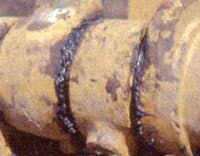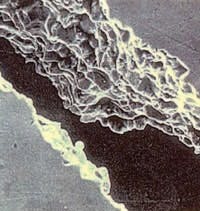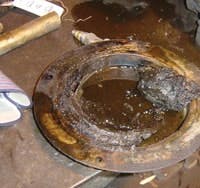A growing trend is to centralize the maintenance and repair purchasing activities. The corporate headquarters may negotiate the best price and delivery and pass that savings on to other divisions and departments. This practice has been common in local, state and federal government for many years. In theory, with comprehensive purchasing requirements, this can make sense when products are of equal performance.
|
View more lubricant content on PlantServics.com |
Figure 1.
Excessive load can squeeze out grease.But let's face facts. The factor influencing a purchasing decision is typically price. Lowest bid gets the job, even though everyone knows this practice is dangerous. Unless the engineering, production and maintenance teams are involved, buying on the basis of price will continue and productivity and reliability will never reach the levels we know are possible.
We've never been in a better position to demand vendor performance. It's important that we require them to comply with our needs. We should generate procurement specifications that not only take price and performance into account but also reduce direct and indirect costs. Sometimes, the smallest, seemingly insignificant item is the most important component on a piece of equipment. Consider the cam bushing in your car's engine. The failure of one such part can contribute to widescale change and costly downtime.
Because of bad grease, a bearing seized, presses stopped, production slowed, profits fell, the factory closed, because of bad grease.
Is this absurd? Actually, it's not that farfetched. Many applications and equipment produce a host of lubrication problems. Extreme heat, excessive pressure, water washout and contamination degrade grease and leave the hardware unprotected. Attempting to understand which grease is best for a given application can be a difficult task. One way to make it easier is to identify why a grease failed, then choose a replacement that can withstand the problem's source. Test methods that relate to these problems--the failure sources--have been established.
Understanding the standards and test results make the selection process less painful. Performance requirements are determined by examining the various bearing failures. Typically, grease is considered a commodity product. Purchasing buys the cheapest grease and the maintenance technicians make sure the bearings always have grease in them. Only when the maintenance and engineering staff actually examine and understand bearing failure modes do they realize performance and bearing life are actually driven by the grease.
Performance
To understand the lube performance requirements, one must establish the cause of downtime and costs of parts replacement and labor before identifying the standards.
Grease solves three main groups of problems:
* Excessive load: force applied to a bearing or journal exceeds the load-carrying capability of the grease ( see Figure 1). The result: metal contact, premature wear and increased temperature.
* Excessive, localized temperature: heat generated during extended operation or localized heat generated as metal asperities collide and produce temperatures in excess of 2,000 F. The result: grease breakdown, cold welding or galling ( see Figure 2).
* Contamination: mud, water and steam can wash away grease, leaving metal unprotected. Exposed grease attracts dust, fibers and abrasive particles that can grind away metal. Acids, caustics and cleaning solutions can degrade grease and corrode metal. The result: premature wear and grease breakdown ( see Figure 3).
Figure 2.
Excessive or localized heat can produce grease breakdown, cold welding or galling.When selecting a lube for a specific application, consider the overall property of the grease. Table 1 connects problems or failure sources to grease properties. It shows a comprehensive list of generally accepted test methods and test result interpretations.
It's essential to evaluate the data before using a grease. The American Society for Testing and Materials (ASTM), a global forum for the development of consensus standards, is an excellent source for establishing purchasing standards. Organized in 1898, it's one of the largest voluntary standards organizations in the world. Known for high technical quality and market relevance, its standards provide an important part of the information that guides design, manufacturing and sales. The full text of any ASTM standard is available electronically, in print via the Web site or through Customer Service at ASTM International (610-832-9585). With generally accepted standards so readily available, there's no reason to deal with a lube vendor that isn't well-versed in the standards applicable to its products.
Figure 3.
Contamination: Mud, water and steam can wash away grease. Dust and abrasive particles can grind away metal. Chemicals can degrade grease and corrode metal.With problems identified and desired performance levels established, the basic steps for a sound procurement process are simple:
1. Identify the problem(s) that lead to failure (thinning grease, varnish formation, bearing wear, water washout, etc.)
2. Identify the standards that address the problem(s) (ASTM and industry-standard values).
3. Select the product that best meets the standard(s).
4. Test the grease in the equipment and compare against what was being used before.
These basic steps lead to long-term cost savings. It's important that the engineering, maintenance and purchasing departments become familiar with the plant's grease problems as well as the ASTM and industry standards that address them. Pressuring vendors to deliver more value and performance increases plant reliability and decreases cost.
Michael Holloway is Director of Technical Development at NCH Corp. in Irving, Texas. He can be reached at [email protected] and (972) 438-0030.
Figures: NCH Corp.




